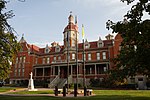George M. Cannon House

The George M. Cannon House, built in 1890, is an historic Late Victorian mansion located at 720 East Ashton Avenue (2340 South) in the Forest Dale area of Salt Lake City, Utah. It was designed by noted Salt Lake architect John A. Headlund for George Mousley Cannon (December 25, 1861 – January 23, 1937), a member of the Cannon family, a prominent Intermountain West political family. In 1889 George M. Cannon had bought Forest Farm from the estate of Brigham Young and created the subdivision of Forest Dale and later the larger town of Forest Dale, which existed from 1902 until 1912, when it was reabsorbed into Salt Lake City. Brigham Young's Forest Farmhouse was moved in 1975 from its location near this house to the This Is The Place Heritage Park for restoration.On July 18, 1983, the George M. Cannon House was added to the National Register of Historic Places (NRHP). It is the only separately listed property in the Forest Dale Historic District, which was added to the NRHP on April 23, 2009.Today the George M. Cannon House is the Parrish Place Bed and Breakfast, so called because each of its guest rooms is named for a different Maxfield Parrish painting. Its current owners are Jeff and Karin Gauvin, whose 2006 quest to purchase the house was featured on HGTV's House Hunters. Reruns of the program have been shown as recently as October 19, 2009.
Excerpt from the Wikipedia article George M. Cannon House (License: CC BY-SA 3.0, Authors, Images).George M. Cannon House
Lake Street, Salt Lake City
Geographical coordinates (GPS) Address Nearby Places Show on map
Geographical coordinates (GPS)
| Latitude | Longitude |
|---|---|
| N 40.719444444444 ° | E -111.86972222222 ° |
Address
Lake Street 2398
84106 Salt Lake City
Utah, United States
Open on Google Maps










